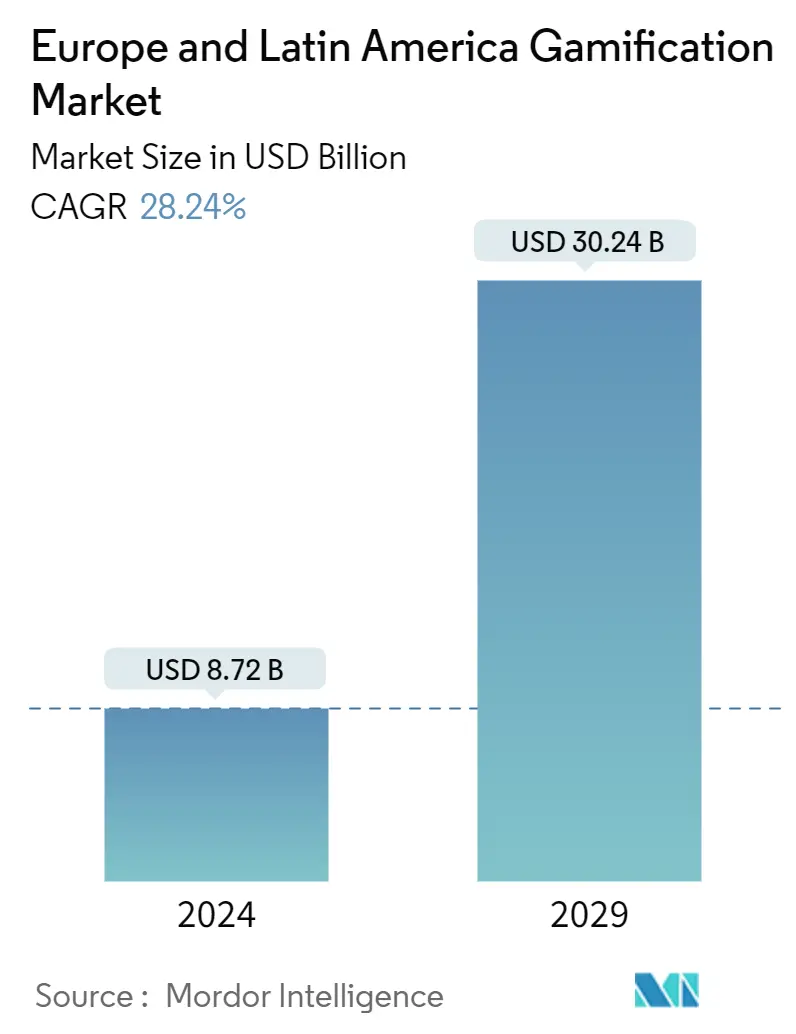Market Size of Europe And Latin America Gamification Industry

| Study Period | 2019 - 2029 |
| Base Year For Estimation | 2023 |
| Market Size (2024) | USD 8.72 Billion |
| Market Size (2029) | USD 30.24 Billion |
| CAGR (2024 - 2029) | 28.24 % |
| Market Concentration | Low |
Major Players
*Disclaimer: Major Players sorted in no particular order |
Europe & Latin America Gamification Market Analysis
The Europe And Latin America Gamification Market size is estimated at USD 8.72 billion in 2024, and is expected to reach USD 30.24 billion by 2029, growing at a CAGR of 28.24% during the forecast period (2024-2029).
The exponential growth in the number of smartphones and mobile devices in the region has boosted the demand for the gamification market. The increasing recognition of gamification systems also supports this growth as a method to architecture human behavior to induce innovation, productivity, or engagement.
- Improved learning outcomes are anticipated to increase the gamification demand among end-users in European and Latin American countries. As a promising learning method, gamification is a growing trend in manufacturing, education, healthcare training, etc.
- Mobile-based gamification is gaining momentum and driving the gamification market in Europe and Latin America. With the widespread use of smartphones and tablets, mobile-based gamification has become an effective way to engage users and create immersive experiences.
- Crowdsourcing has emerged as a significant opportunity in innovation and development, and it has also been driving the gamification market. Crowdsourcing involves sourcing ideas, content, or services from a large group of people, often via the Internet. Gamification can motivate and engage the crowd, making it an effective tool for crowdsourcing initiatives.
- The development of gamification solutions can be complex, posing a challenge and restraining the gamification market. Developing effective game mechanics that are engaging, motivating, and aligned with the business objectives can be challenging. It requires a deep understanding of user behavior, psychology, and motivations that may restrain market growth.
- The COVID-19 pandemic accelerated the adoption of digital technologies and forced companies to shift to remote work and virtual learning. This created new opportunities for gamification as companies look for ways to engage and motivate employees and customers in a virtual environment. The gamification market is expected to grow in the post-COVID-19 era, driven by the ongoing digital transformation and the need for engaging and effective virtual experiences.
Europe & Latin America Gamification Industry Segmentation
Gamification uses the human tendency to influence one's thinking process by engaging users to become effective problem solvers, even in the real world. Gamification has proven its benefits in different activities, such as customer experience enrichment, employee engagement, and rewards to people.
Europe and Latin America gamification market is segmented by type (solution, services), by end-user vertical (retail, healthcare, education, banking and finance, telecommunications & IT), by geography (Europe (Italy, Germany, United Kingdom, Rest of Europe), Latin America (Brazil, Mexico, Rest of Latin America)). The market sizes and forecasts are provided in terms of value in USD for all the above segments.
| By Type | |
| Solution | |
| Services |
| By End User Vertical | |
| Retail | |
| Healthcare | |
| Education | |
| Banking and Finance | |
| Telecommunications & IT | |
| Other End-user Vertical |
| By Geography | ||||||
| ||||||
|
Europe And Latin America Gamification Market Size Summary
The gamification market in Europe and Latin America is experiencing significant growth, driven by the increasing adoption of digital technologies and the widespread use of smartphones and mobile devices. This market expansion is fueled by the recognition of gamification as an effective tool to enhance engagement, productivity, and innovation across various sectors such as education, healthcare, and manufacturing. The trend is further supported by the rise of mobile-based gamification, which offers immersive experiences and engages users effectively. Additionally, the COVID-19 pandemic has accelerated the shift towards digital solutions, creating new opportunities for gamification in virtual environments. Despite the complexities involved in developing effective gamification solutions, the market is poised for substantial growth, supported by ongoing digital transformation efforts.
In Europe, gamification is increasingly being utilized in retail to enhance customer engagement and loyalty through interactive loyalty programs and immersive shopping experiences. Retailers are also leveraging gamification to promote social responsibility and sustainability initiatives. The high penetration of internet and smartphone users in the region has facilitated the integration of gamification in marketing strategies, particularly through social media. The presence of a robust gaming industry in countries like Germany and the United Kingdom provides a strong foundation for gamification projects. The market is characterized by fragmentation, with key players engaging in strategic partnerships and acquisitions to strengthen their offerings. As advanced technologies like artificial intelligence and virtual reality continue to evolve, they are expected to further enhance the gamification experience, driving continued market growth.
Europe And Latin America Gamification Market Size - Table of Contents
-
1. MARKET INSIGHTS
-
1.1 Market Overview
-
1.2 Industry Attractiveness - Porter's Five Forces Analysis
-
1.2.1 Bargaining Power of Suppliers
-
1.2.2 Bargaining Power of Consumers
-
1.2.3 Threat of New Entrants
-
1.2.4 Intensity of Competitive Rivalry
-
1.2.5 Threat of Substitutes
-
-
1.3 Impact of COVID-19 on Gamification and Digital Engagement Strategies
-
1.4 Evolution of Gamification and the Current Positioning of Europe and Latin America in the Global Scenario
-
-
2. MARKET SEGMENTATION
-
2.1 By Type
-
2.1.1 Solution
-
2.1.2 Services
-
-
2.2 By End User Vertical
-
2.2.1 Retail
-
2.2.2 Healthcare
-
2.2.3 Education
-
2.2.4 Banking and Finance
-
2.2.5 Telecommunications & IT
-
2.2.6 Other End-user Vertical
-
-
2.3 By Geography
-
2.3.1 Europe
-
2.3.1.1 Italy
-
2.3.1.2 Germany
-
2.3.1.3 United Kingdom
-
2.3.1.4 Rest of Europe
-
-
2.3.2 Latin America
-
2.3.2.1 Brazil
-
2.3.2.2 Mexico
-
2.3.2.3 Rest of Latin America
-
-
-
Europe And Latin America Gamification Market Size FAQs
How big is the Europe And Latin America Gamification Market?
The Europe And Latin America Gamification Market size is expected to reach USD 8.72 billion in 2024 and grow at a CAGR of 28.24% to reach USD 30.24 billion by 2029.
What is the current Europe And Latin America Gamification Market size?
In 2024, the Europe And Latin America Gamification Market size is expected to reach USD 8.72 billion.

